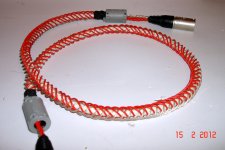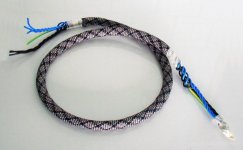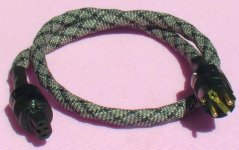Balanced inputs and outputs are invented to reduce noise picked by cables,
Balancing will not make sound better, it will just add more electronics in sound path.
It is good for long microphone cables with low level signals, also in recording studios with kilometers of cabling.
But for short paths, counter-rotating helix geometry is a winner.
"With digital sources it was almost as if we had switched from 44.1k/16 bit to96k/24 bit. We now run all our analogue machines, workstations and the mixing console from the Shunyata equipment."
-- Andy Jackson, Senior Mastering Engineer: Astoria Studio UK
"The Anaconda PowerSnakes, have transformed our Sonoma system, used during the mastering process for the new 5.1 SACD mix of 'The Dark Side of The Moon'."
-- James Guthrie, Grammy award winning Producer/Engineer (Pink Floyd)
Balancing will not make sound better, it will just add more electronics in sound path.
It is good for long microphone cables with low level signals, also in recording studios with kilometers of cabling.
But for short paths, counter-rotating helix geometry is a winner.
"With digital sources it was almost as if we had switched from 44.1k/16 bit to96k/24 bit. We now run all our analogue machines, workstations and the mixing console from the Shunyata equipment."
-- Andy Jackson, Senior Mastering Engineer: Astoria Studio UK
"The Anaconda PowerSnakes, have transformed our Sonoma system, used during the mastering process for the new 5.1 SACD mix of 'The Dark Side of The Moon'."
-- James Guthrie, Grammy award winning Producer/Engineer (Pink Floyd)
white conductor is not a part of helix geometry
"Some embodiments of the present invention
also comprise drain wires which are not interlacing elements
and which run longitudinally within or adjacent to the helices.
Shielding may also be employed to help reduce noise from external sources."
it is commonly used for grounding, and should be larger in diameter
(easier to braid)
there is 6+6 awg13 conductors
and it is only for heavy loads (amplifiers, welding machines etc)
I hope this helps
Thanks for the information & pic
I have few questions:
-12 conductors of 6 awg each for power? no conductor for ground?
-how many conductors and awg for signal? balanced cable no conductor for ground?
-or all cable have to be shielded with a copper/silver braid?
Last edited:
2x3 conductors in helix geometry, each 2,5mm²
sum 2x7,5mm² (somewhere between 8 and 9 AWG)
central ground wire 6mm²,
crimped with copper end sleeves,
wattgate connectors
now connected on my old pc monitor for pre burn in
sum 2x7,5mm² (somewhere between 8 and 9 AWG)
central ground wire 6mm²,
crimped with copper end sleeves,
wattgate connectors
now connected on my old pc monitor for pre burn in
Attachments
strange argument, just because balanced interconnects and equipment was invented for long cable runs, does not mean its inferior for short runs, its still better to make a balanced interconnect so that it actually makes use of the balanced connection. Making it so that it doesnt, but still using it balanced will make it worse, not better.
very pretty though
very pretty though
Balanced inputs and outputs are invented to reduce noise picked by cables,
Balancing will not make sound better, it will just add more electronics in sound path.
It is good for long microphone cables with low level signals, also in recording studios with kilometers of cabling.
But for short paths, counter-rotating helix geometry is a winner.
"With digital sources it was almost as if we had switched from 44.1k/16 bit to96k/24 bit. We now run all our analogue machines, workstations and the mixing console from the Shunyata equipment."
-- Andy Jackson, Senior Mastering Engineer: Astoria Studio UK
"The Anaconda PowerSnakes, have transformed our Sonoma system, used during the mastering process for the new 5.1 SACD mix of 'The Dark Side of The Moon'."
-- James Guthrie, Grammy award winning Producer/Engineer (Pink Floyd)
A balanced circuit is a two-conductor circuit in which both conductors and all circuits connected to them have the same impedance with respect to ground and to all other conductors. The purpose of balancing is to make the noise pickup equal in both conductors, in which case it will be
a common-mode signal that can be made to cancel out in the load
And most critical point is microphone input at studio mixing console
or various microphone amplifiers and processors.
In home, only low level signal source is turntable.
Main problem is a cable. Every cable will change sound
due to internal impedance, and it will pick surrounding noise more or less.
There is no perfect cable on our planet.
With helix geometry you have a cable highly resistant to externally induced distortion, minimized distortion caused by "skin-effect" and minimized internal impedance.
Shielding may also be employed to help reduce noise from external sources.
And in home appliances, with helix cable, you can eliminate external noises in that level that balanced circuit will only degrade sound.
And, no I don' work for Shunyata
I am only a studio technician with great respect to my friends recording engineers.
Recording engineers don't suffer from audiophilia. They aren't voodoo priests believing in psychological spells that could convince them something sounds good when it doesn't. They're purely result-oriented. They trust their own ears implicitly. Sound is their livelihood, their studios finely calibrated laboratories. You insert something new, they know immediately whether it's better or not.
sorry was your post supposed to argue against balanced interconnects?
skin effect has no meaningful effect at audio and certainly not power frequencies and you would want to use a much thinner conductor than 16awg if it did. you seem to be just regurgitating marketing buzzwords without knowing what they mean, or how they effect application.
there is no question your helical cable will only put MORE stress on CMMR of the system, not help it, your cable is a source of error; but it is very skillfully made
engineers are not lacking human qualities
skin effect has no meaningful effect at audio and certainly not power frequencies and you would want to use a much thinner conductor than 16awg if it did. you seem to be just regurgitating marketing buzzwords without knowing what they mean, or how they effect application.
there is no question your helical cable will only put MORE stress on CMMR of the system, not help it, your cable is a source of error; but it is very skillfully made
engineers are not lacking human qualities
And most critical point is microphone input at studio mixing console
or various microphone amplifiers and processors.
In home, only low level signal source is turntable.
Main problem is a cable. Every cable will change sound
due to internal impedance, and it will pick surrounding noise more or less.
There is no perfect cable on our planet.
With helix geometry you have a cable highly resistant to externally induced distortion, minimized distortion caused by "skin-effect" and minimized internal impedance.
Shielding may also be employed to help reduce noise from external sources.
And in home appliances, with helix cable, you can eliminate external noises in that level that balanced circuit will only degrade sound.
And, no I don' work for Shunyata
I am only a studio technician with great respect to my friends recording engineers.
Last edited:
No I am not arguing against balanced interconnects,
it is used in all studios around the world,
but majority of home audio systems are fully unbalanced,
and lot of these systems work hum and buzz-free every day.
The headaches begin when one tries to add a balanced unit to
home system.
Equipment manufacturers do not use always the same solution
for balancing signals. Common problem is grounding.
Fully balanced systems provide the best performance,
but at home, you will need all equipment to be fully balanced.
Connecting unbalanced and balanced units together is possible
but it is not the best solution.
Studios around the world have all equipment balanced
but still have connectivity problems.
And I don't think that all people talking about shunyata are
marketing buzzwords.
Shunyata Research: Professional Endorsements
it is used in all studios around the world,
but majority of home audio systems are fully unbalanced,
and lot of these systems work hum and buzz-free every day.
The headaches begin when one tries to add a balanced unit to
home system.
Equipment manufacturers do not use always the same solution
for balancing signals. Common problem is grounding.
Fully balanced systems provide the best performance,
but at home, you will need all equipment to be fully balanced.
Connecting unbalanced and balanced units together is possible
but it is not the best solution.
Studios around the world have all equipment balanced
but still have connectivity problems.
And I don't think that all people talking about shunyata are
marketing buzzwords.
Shunyata Research: Professional Endorsements
"I've run out of words to describe the profound effect Shunyata Research products have had on the SACD experience in our studio."
-- Jon Truckenmiller, Sr. VP Engineering: Crest National Studios
We had a comparison between the Shunyata, MIT and my DIY Allen Wright 40 gauge twisted around a 3mm OD Teflon tube. The Shunyata was only slightly better. The Shanyata didnt go up against my Wright silver ribbons with Eichmann silver bullets...yet. The Shunyata were $6k list. My DIY 40 gauge were less than $10 a pair. Three people listened. We all heard the same thing.
Buy the book. Small price to pay for good cables.
Buy the book. Small price to pay for good cables.
I just trying to help people to make their own helix geometry cable.
I think that we are going off topic.
Cant wait to test my cables and post results.
sorry marce, here is it:
I think that we are going off topic.
Cant wait to test my cables and post results.
sorry marce, here is it:
Another distortion-causing problem found in audio interconnect
cables is the so-called "skin effect" occurring with
broad-band audio signals transmitted through multiple conductor
cables. Prior art cables with multiple conductors
exhibit an effect whereby high-frequency components of the
audio signal tend to propagate toward conductors around the
periphery of the cable while low-frequency components of
the audio signal tend to propagate toward conductors in the
center of the cable. The overall effect, thought to be caused
by electromagnetic effects of signals in the periphery of the
cable, results in signals around the periphery of the cable
traveling faster than signals traveling along the center of the
cable. This phenomenon results in a time distortion of the
signal as high-frequency components arriving first at the
destination followed by the low-frequency components
which started at the same time as the high-frequency components.
As a consequence, the signal arriving at the destination
is distorted from the original signal..
marce is an DSP, high speed digital and systems engineer, he just as I do, knows very well what skin effect is. We also know that it does not impact analogue audio frequency interconnection in any meaningful way, or power cabling with realistic sizes AT ALL.
its often used to try and sell audio cables, but they are stretching the truth and anyway 16awg has a full 100% depth at 11khz, so if it means something to you, you should be using something smaller. Your smaller wires will be working together to form a larger gauge anyway.
if you are worried about that and believe braiding will act as each signal conductor is separate, then you should be using 22-28awg for signal, thats the easiest and most effective way to tackle it for signals that dont have significant current
in a braid like you have there, IF each conductor acted as a separate entity, then any error caused by skin effect will be swamped by the real physical difference in the lengths of the conductors caused by the braiding, as well as all the other effects such as the capacitance, the crosstalk etc
for power conduction you still have 100% depth at 125Hz when using 4/0 AWG 11.684mm conductors!
its a real effect to be aware of with digital and RF systems, but line level analogue its not worth worrying about, if you do worry about it, just dont make 16awg XLR cables, use something more sensible like 20-28awg
but like I said its very skillful and the capacitance/crosscoupling for power cabling is unlikely to be a worry; for XLR its doing more harm than good.
its often used to try and sell audio cables, but they are stretching the truth and anyway 16awg has a full 100% depth at 11khz, so if it means something to you, you should be using something smaller. Your smaller wires will be working together to form a larger gauge anyway.
if you are worried about that and believe braiding will act as each signal conductor is separate, then you should be using 22-28awg for signal, thats the easiest and most effective way to tackle it for signals that dont have significant current
in a braid like you have there, IF each conductor acted as a separate entity, then any error caused by skin effect will be swamped by the real physical difference in the lengths of the conductors caused by the braiding, as well as all the other effects such as the capacitance, the crosstalk etc
for power conduction you still have 100% depth at 125Hz when using 4/0 AWG 11.684mm conductors!
its a real effect to be aware of with digital and RF systems, but line level analogue its not worth worrying about, if you do worry about it, just dont make 16awg XLR cables, use something more sensible like 20-28awg
but like I said its very skillful and the capacitance/crosscoupling for power cabling is unlikely to be a worry; for XLR its doing more harm than good.
Last edited:
thanks qusp,
Yes, I find similar info in various books and industrial measurements.
I never try to engineering new cable, just to copy existing one.
Since this is my first attempt to do something serious with audio cable,
I will certainly experiment more in the future.
Yes, I find similar info in various books and industrial measurements.
I never try to engineering new cable, just to copy existing one.
Since this is my first attempt to do something serious with audio cable,
I will certainly experiment more in the future.
Last edited:
Hi, they are nice looking cables, but as Qusp as stated, skin effect has a minute effect at audio frequencies.
I actually do high speed layout etc, and for my crimes agains PCB design I am sat in an office at the ABC centre next to munich airport doing a course on high speed signal integrity and power deliver system integrity. Even at the frequecies we are using for examples skin effect is not a consideration, high speed digital, DDR3 etc. When skin effect does kick in though for digital it is more problematic depending on whether the trace is routed as microstrip or stripline as the current density is not even. In microstrip the current density is biggest at the bottom of the trace, nearest the return path (usually a ground plane), so the calculators have even more fun and frequency dependent resistance start raising its ugly head.
Sorry to go on, but i do beleive in audio we are better concentrating on phenomena that realy degrade the signal and the related problems.
I actually do high speed layout etc, and for my crimes agains PCB design I am sat in an office at the ABC centre next to munich airport doing a course on high speed signal integrity and power deliver system integrity. Even at the frequecies we are using for examples skin effect is not a consideration, high speed digital, DDR3 etc. When skin effect does kick in though for digital it is more problematic depending on whether the trace is routed as microstrip or stripline as the current density is not even. In microstrip the current density is biggest at the bottom of the trace, nearest the return path (usually a ground plane), so the calculators have even more fun and frequency dependent resistance start raising its ugly head.
Sorry to go on, but i do beleive in audio we are better concentrating on phenomena that realy degrade the signal and the related problems.
Hi marce, I am glad to met here various specialists, and I am always ready to learn.
About cables, well, there is always some snake oil involved, but we love diy, it's lot of fun, especialy if you done something right.
Also have plans to build s/pdif cables with some cheap materials. Any suggestions?
About cables, well, there is always some snake oil involved, but we love diy, it's lot of fun, especialy if you done something right.
Also have plans to build s/pdif cables with some cheap materials. Any suggestions?
- Status
- This old topic is closed. If you want to reopen this topic, contact a moderator using the "Report Post" button.
- Home
- Design & Build
- Parts
- diy shunyata research (Helix Geometry) cable?


